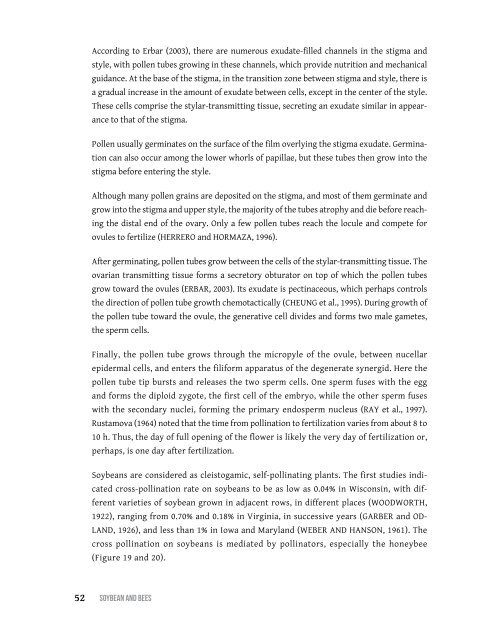Soybean and Bees
Create successful ePaper yourself
Turn your PDF publications into a flip-book with our unique Google optimized e-Paper software.
According to Erbar (2003), there are numerous exudate-filled channels in the stigma <strong>and</strong><br />
style, with pollen tubes growing in these channels, which provide nutrition <strong>and</strong> mechanical<br />
guidance. At the base of the stigma, in the transition zone between stigma <strong>and</strong> style, there is<br />
a gradual increase in the amount of exudate between cells, except in the center of the style.<br />
These cells comprise the stylar-transmitting tissue, secreting an exudate similar in appearance<br />
to that of the stigma.<br />
Pollen usually germinates on the surface of the film overlying the stigma exudate. Germination<br />
can also occur among the lower whorls of papillae, but these tubes then grow into the<br />
stigma before entering the style.<br />
Although many pollen grains are deposited on the stigma, <strong>and</strong> most of them germinate <strong>and</strong><br />
grow into the stigma <strong>and</strong> upper style, the majority of the tubes atrophy <strong>and</strong> die before reaching<br />
the distal end of the ovary. Only a few pollen tubes reach the locule <strong>and</strong> compete for<br />
ovules to fertilize (Herrero <strong>and</strong> Hormaza, 1996).<br />
After germinating, pollen tubes grow between the cells of the stylar-transmitting tissue. The<br />
ovarian transmitting tissue forms a secretory obturator on top of which the pollen tubes<br />
grow toward the ovules (Erbar, 2003). Its exudate is pectinaceous, which perhaps controls<br />
the direction of pollen tube growth chemotactically (Cheung et al., 1995). During growth of<br />
the pollen tube toward the ovule, the generative cell divides <strong>and</strong> forms two male gametes,<br />
the sperm cells.<br />
Finally, the pollen tube grows through the micropyle of the ovule, between nucellar<br />
epidermal cells, <strong>and</strong> enters the filiform apparatus of the degenerate synergid. Here the<br />
pollen tube tip bursts <strong>and</strong> releases the two sperm cells. One sperm fuses with the egg<br />
<strong>and</strong> forms the diploid zygote, the first cell of the embryo, while the other sperm fuses<br />
with the secondary nuclei, forming the primary endosperm nucleus (Ray et al., 1997).<br />
Rustamova (1964) noted that the time from pollination to fertilization varies from about 8 to<br />
10 h. Thus, the day of full opening of the flower is likely the very day of fertilization or,<br />
perhaps, is one day after fertilization.<br />
<strong>Soybean</strong>s are considered as cleistogamic, self-pollinating plants. The first studies indicated<br />
cross-pollination rate on soybeans to be as low as 0.04% in Wisconsin, with different<br />
varieties of soybean grown in adjacent rows, in different places (Woodworth,<br />
1922), ranging from 0.70% <strong>and</strong> 0.18% in Virginia, in successive years (Garber <strong>and</strong> Odl<strong>and</strong>,<br />
1926), <strong>and</strong> less than 1% in Iowa <strong>and</strong> Maryl<strong>and</strong> (Weber <strong>and</strong> Hanson, 1961). The<br />
cross pollination on soybeans is mediated by pollinators, especially the honeybee<br />
(Figure 19 <strong>and</strong> 20).<br />
52 SoybeAn <strong>and</strong> bees


